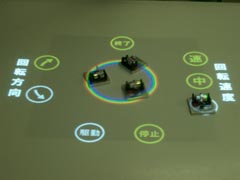Department of Sensory Media
Project | Proactive Desk II
Development of a New Multi-object Haptic Display Using a Linear Induction Motor
Introduction | Materials | Publications | Members
Introduction
It is important that in an intuitive interaction environment objects are monitored and handled seamlessly. However, current methods of controlling computer operations, such as using a mouse and icons, on a display, are far from an ideal type of environment. If users could instead grasp physical objects directly or select items from visual icons seamlessly, it would make users feel more comfortable when using computers. A truly intuitive, direct interaction environment would make it much easier to share a workspace with other people, thus it would improve the efficiency of cooperative work.
There have been many studies aimed at achieving such environments. One example is Digital Desk (Wellner in 1991). In these environments, users can input information using physical objects and bodily gestures. However, most systems can output information only via visual and audio channels, although information can be input by using other channels such as tactile sensors.
The Proactive Desk we have developed is a solution for adding another output channel from the computer for such an interactive environment. The system's layout resembles an ordinary desk, and it is able to present users with visual and audio information as well as physical information, that is, force (haptic information). To present visual and audio information, we use the popular means of an overhead projector, which projects an image onto the desktop, and speakers. To present haptic information, we move real objects on the desktop physically. As for the mechanism, the system employs two linear induction motors (LIM) arranged underneath the desktop. They can generate force in two-dimensional arbitrary directions to a nonmagnetic conductive metal plate (we call this a "forcer") on the desktop. When users handle the forcer, they can acquire haptic information. The system also presents physical icons by controlling the forcer's position together with visual icons. However, the limitation of only being able to generate force to a single forcer has been a problem for applying the system to cooperative multi-user tasks.
In this study, we propose a new-generation haptic display, Proactive Desk II, which uses an advanced LIM for multi-object driving, and develop a prototype system based on our approach. The system employs a cluster of coils for producing magnetic fluxes individually underneath the desktop, and those synthesize several traveling magnetic fields as a result. These magnetic fields simulate a local region of the field generated by our first-generation system, being able to drive multiple objects separately.
Materials
Experience of virtual walls in digital maze


Motion control of real objects on the desk


Publications
-
Proactive Desk II: Development of a New Multi-object Haptic Display Using a Linear Induction Motor
Shunsuke YOSHIDA, Haruo NOMA, Kenichi HOSAKA
IEEE VR 2006, 2006.3.
Members
- Shunsuke YOSHIDA
- Haruo NOMA
- Ken-ichi HOSAKA
